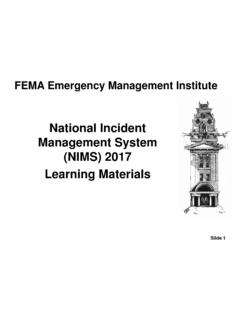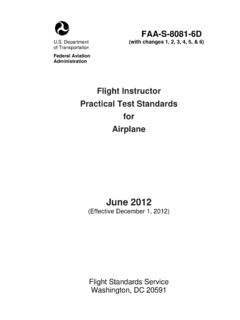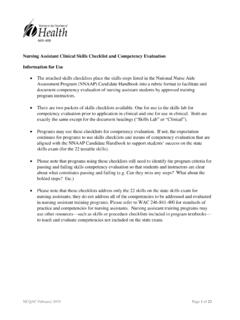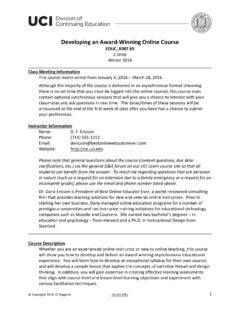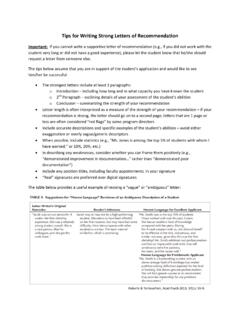Transcription of Flight Instructor Instrument Practical Test Standards for ...
1 FAA-S-8081-9D. Department with Changes 1 & 2. of Transportation Federal Aviation Administration Flight Instructor . Instrument . Practical Test Standards for AIRPLANE. and HELICOPTER. July 2010. Flight Standards SERVICE. Washington, DC 20591. Flight Instructor . Instrument . Practical Test Standards for AIRPLANE. and HELICOPTER. 2010. Flight Standards SERVICE. Washington, DC 20591. NOTE. Material in FAA-S-8081-9D will be effective July 1, 2010. All previous editions of the Flight Instructor Instrument Practical Test Standards will be obsolete as of this date. MAJOR ENHANCEMENTS. Introduction: 1.
2 Added abbreviations 2. Special Emphasis Areas updated 3. Replaced APV note with LPV verbiage in Aircraft and Equipment Required for the Practical Test section 4. Deleted Aeronautical Decision Making and Risk Management and replaced with Single-Pilot resource Management 5. Emphasis on Attitude Instrument Flying and Partial Panel Skills updated 6. Renewal or Reinstatement of a Flight Instructor Task L. changed to Task D. 7. Added section titled Use of the Judgment Assessment Matrix Examiner's Practical Test Checklist Item I. H. deleted. Area of Operations 1. AREA OF OPERATION I, Task B, Objective updated 2.
3 AREA OF OPERATION I, Task D, added item 7 to include scenario based training method 3. AREA OF OPERATION IX, Task D, added Multiengine to the Task title Appendices 1. Appendix 1 introduction updated 2. Added Appendices 2 and 3. FAA-S-8081-9D. RECORD OF CHANGES. Change 1 5/3/2012. Appendix 1, deleted columns 1, 2, and 3. Deleted Appendix 2: Non-FSTD Credit Change 2 4/18/2014. Added Instructor to the title of the Addition of an Instrument Rating to a Flight Instructor Certificate table (page 20). Removed the Glider ( G ) column from the Addition of an Instrument Instructor Rating to a Flight Instructor Certificate table and revised the Legend (page 20).
4 FOREWORD. The Flight Instructor Instrument Practical Test Standards (PTS) book has been published by the Federal Aviation Administration (FAA) to establish the Standards for Flight Instructor certification and Instrument rating Practical tests for airplanes and helicopters. FAA inspectors and designated pilot examiners shall conduct Practical tests in compliance with these Standards . Flight instructors and applicants should find these Standards helpful during training and when preparing for the Practical test. /s/ 5-03-2010. Van Kerns, Manager Regulatory Support Division Flight Standards Service FAA-S-8081-9D.
5 CONTENTS. 1. General 1. Practical Test Standard 2. Flight Instructor Practical Test Book 2. 5. Use of the Practical Test Standards .. 6. Use of the Judgment Assessment Matrix .. 7. Special Emphasis Areas .. 8. Aircraft and Equipment Required for the Practical Test .. 8. Use of FAA-Approved Flight Simulation Training Device (FSTD) . 10. Flight Instructor Responsibility .. 11. Examiner Responsibility .. 12. Satisfactory Performance .. 13. Unsatisfactory Performance .. 13. Letter of 14. Single-Pilot resource Management .. 14. 1. Aeronautical Decision Making .. 15. 2. Risk 15. 3. Task 16.
6 4. Situational Awareness .. 16. 5. Controlled Flight Into Terrain Awareness .. 17. 6. Automation Management .. 17. Applicant's Use of Checklists .. 18. Use of Distractions During Practical Tests .. 18. Positive Exchange of Flight 18. Emphasis on Attitude Instrument Flying and Partial Panel Skills .. 19. Addition of an Instrument Rating to a Flight Instructor Certificate .. 20. Renewal or Reinstatement of a Flight Instructor .. 21. CHECKLISTS. Applicant's Practical Test 1-i Examiner's Practical Test Checklist .. 1-iii AREAS OF OPERATION. I. FUNDAMENTALS OF INSTRUCTING. A. Learning Process.
7 1-1. B. Human Behavior and Effective 1-1. C. Teaching D. Teaching 1-2. E. Critique and 1-2. F. Flight Instructor Characteristics and Responsibilities .. 1-3. G. Planning Instructional 1-3. i FAA-S-8081-9D. II. TECHNICAL SUBJECT AREAS. A. Aircraft Flight instruments and Navigation Equipment ..1-4. B. Aeromedical Factors .. 1-5. C. Regulations and Publications Related to IFR Operations .. 1-5. D. Logbook Entries Related to Instrument Instruction ..1-6. lll. PREFLIGHT PREPARATION. A. Weather Information .. 1-7. B. Cross-Country Flight Planning .. 1-8. C. Instrument Cockpit Check.
8 1-8. IV. PREFLIGHT LESSON ON A MANEUVER TO BE PERFORMED. IN Flight . A. Maneuver 1-10. V. AIR TRAFFIC CONTROL CLEARANCES AND PROCEDURES. A. Air Traffic Control Clearances .. 1-11. B. Compliance With Departure, En Route, and Arrival Procedures and 1-11. VI. Flight BY REFERENCE TO instruments . A. Straight-and-Level Flight .. 1-12. B. Turns .. 1-13. C. Change of Airspeed in Straight-and-Level and Turning D. Constant Airspeed Climbs and E. Constant Rate Climbs and 1-16. F. Timed Turns to Magnetic Compass Headings .. 1-17. G. Steep Turns .. 1-18. H. Recovery From Unusual Flight Attitudes.
9 1-19. VII. NAVIGATION SYSTEMS. A. Intercepting and Tracking Navigational Systems and DME Arcs ..1-20. B. Holding VIII. Instrument APPROACH PROCEDURES. A. Nonprecision Instrument 1-22. B. Precision Instrument Approach .. 1-24. C. Missed Approach .. 1-25. D. Circling Approach (Airplane) .. 1-26. E. Landing From a Straight-In Approach ..1-27. ii FAA-S-8081-9D. IX. EMERGENCY OPERATIONS. A Loss of Communications ..1-28. B. Approach With Loss of Primary Flight Instrument Indicators .. 1-28. C. Engine Failure During Straight-and-Level Flight and 1-29. D. Instrument Approach One Engine Inoperative.
10 1-30. X. POSTFLIGHT PROCEDURES. A. Checking instruments and 1-32. APPENDIX 1: Flight SIMULATION TRAINING DEVICE CREDIT. Task vs. Flight Simulation Training Device (FSTD) A1-1. Use of Chart .. A1-1. Flight Simulation Training Device (FSTD) Level .. A1-2. APPENDIX 2: NON-FSTD CREDIT. Task vs. Non-FSTD Credit (Other Training Devices).. A2-1. Use of Chart .. A2-1. Non-FSTD Level .. A2-2. APPENDIX 3: JUDGMENT ASSESSMENT MATRIX: Flight . Instructor Instrument . Judgment Assessment Matrix .. A3-1. Purpose of the Assessment .. A3-2. Directions for Completion of the Assessment .. A3-2. Definitions of resource Management A3-2.










